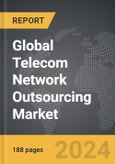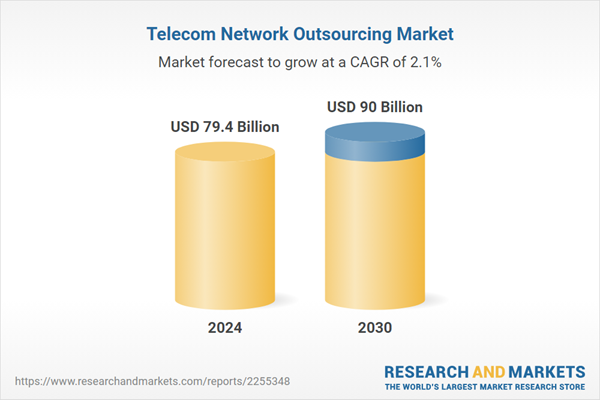Global Telecom Network Outsourcing Market - Key Trends and Drivers Summarized
In the evolving landscape of telecommunications, outsourcing network services has become an increasingly prevalent strategy, driven by the need for companies to deliver improved services swiftly without the high costs associated with maintaining and upgrading network infrastructures internally. This approach involves transferring specific company activities and associated staff to an external service provider, thus converting fixed costs into variable ones and significantly slashing capital expenditures. Outsourcing promises substantial savings, estimated at about 20%-30% on operating costs, and boosts employee productivity by allowing businesses to focus more on their core functions rather than network management. Network outsourcing has become a strategic element in operations across various industries, not just a service, offering managed, integrated network solutions without the burdens of ownership or direct management, driven by the necessity to reduce expenses and adapt quickly to technological advancements.The shift towards outsourcing in telecommunications is underscored by its role in facilitating network convergence and allowing companies to entrust internal operations to a service provider under long-term agreements. This not only cuts down on in-house fixed costs but also lets the service provider use its specialized expertise to reduce service costs while still profiting. Particularly beneficial in regions like Latin America, Asia-Pacific, and Africa, where financial constraints might delay new technology deployments, outsourcing redefines core competencies within telecommunications firms, focusing them more on product innovation and customer management rather than traditional network operations. Network convergence, enabled by technologies such as VoIP, integrates various services like application sharing, voice and video conferencing, and on-demand services into a unified network, fostering not only cost reductions but also the quick deployment of new services, thereby enhancing customer offerings.
However, outsourcing network services comes with its own set of challenges, including concerns about confidentiality, loss of internal knowledge, cultural mismatches, and dependency on the financial health of the outsourcing partner. These concerns necessitate a strategic approach to outsourcing, viewing it not just as a cost-cutting measure but as a partnership aligned with long-term business objectives. Companies in the telecommunications sector, from established carriers to newer market entrants, find outsourcing particularly beneficial as it allows them to access advanced technology incrementally and expand their service reach efficiently. Key factors driving the growth of network outsourcing include regulatory compliance, rapid technological advancements, a focus on core competencies, globalization of services, consumer demand for seamless connectivity, a shift from capital expenditure to operational expenditure, and the integration of advanced data analytics. These elements highlight the complex and strategic nature of decisions in telecom network outsourcing, transcending mere cost considerations to address broader business needs and market dynamics.
Report Scope
The report analyzes the Telecom Network Outsourcing market, presented in terms of market value. The analysis covers the key segments and geographic regions outlined below.- Segments: Type (Mobile Network, Fixed Network).
- Geographic Regions/Countries: World; United States; Canada; Japan; China; Europe (France; Germany; Italy; United Kingdom; and Rest of Europe); Asia-Pacific; Rest of World.
Key Insights:
- Market Growth: Understand the significant growth trajectory of the Mobile Network Outsourcing segment, which is expected to reach US$65.6 Billion by 2030 with a CAGR of a 4%. The Fixed Network Outsourcing segment is also set to grow at -2% CAGR over the analysis period.
- Regional Analysis: Gain insights into the U.S. market, valued at $21.1 Billion in 2024, and China, forecasted to grow at an impressive 1.9% CAGR to reach $14.4 Billion by 2030. Discover growth trends in other key regions, including Japan, Canada, Germany, and the Asia-Pacific.
Why You Should Buy This Report:
- Detailed Market Analysis: Access a thorough analysis of the Global Telecom Network Outsourcing Market, covering all major geographic regions and market segments.
- Competitive Insights: Get an overview of the competitive landscape, including the market presence of major players across different geographies.
- Future Trends and Drivers: Understand the key trends and drivers shaping the future of the Global Telecom Network Outsourcing Market.
- Actionable Insights: Benefit from actionable insights that can help you identify new revenue opportunities and make strategic business decisions.
Key Questions Answered:
- How is the Global Telecom Network Outsourcing Market expected to evolve by 2030?
- What are the main drivers and restraints affecting the market?
- Which market segments will grow the most over the forecast period?
- How will market shares for different regions and segments change by 2030?
- Who are the leading players in the market, and what are their prospects?
Report Features:
- Comprehensive Market Data: Independent analysis of annual sales and market forecasts in US$ Million from 2024 to 2030.
- In-Depth Regional Analysis: Detailed insights into key markets, including the U.S., China, Japan, Canada, Europe, Asia-Pacific, Latin America, Middle East, and Africa.
- Company Profiles: Coverage of players such as ADTRAN, Inc., Advantech Co., Ltd., Allied Telesis, Inc., AudioCodes Ltd., Avaya, Inc. and more.
- Complimentary Updates: Receive free report updates for one year to keep you informed of the latest market developments.
Some of the 31 companies featured in this Telecom Network Outsourcing market report include:
- Ciena Corporation
- Cisco Systems Inc.
- Fujitsu Limited
- Hewlett Packard Enterprise Co.
- Huawei Technologies Co. Ltd.
- IBM Corp.
- Juniper Networks Inc.
- Motorola Solutions Inc.
- NEC Corporation
- Nokia Networks
- Telefonaktiebolaget LM Ericsson
- Tellabs Inc.
- UTStarcom Holdings Corp.
- ZTE Corporation
This edition integrates the latest global trade and economic shifts into comprehensive market analysis. Key updates include:
- Tariff and Trade Impact: Insights into global tariff negotiations across 180+ countries, with analysis of supply chain turbulence, sourcing disruptions, and geographic realignment. Special focus on 2025 as a pivotal year for trade tensions, including updated perspectives on the Trump-era tariffs.
- Adjusted Forecasts and Analytics: Revised global and regional market forecasts through 2030, incorporating tariff effects, economic uncertainty, and structural changes in globalization. Includes historical analysis from 2015 to 2023.
- Strategic Market Dynamics: Evaluation of revised market prospects, regional outlooks, and key economic indicators such as population and urbanization trends.
- Innovation & Technology Trends: Latest developments in product and process innovation, emerging technologies, and key industry drivers shaping the competitive landscape.
- Competitive Intelligence: Updated global market share estimates for 2025, competitive positioning of major players (Strong/Active/Niche/Trivial), and refined focus on leading global brands and core players.
- Expert Insight & Commentary: Strategic analysis from economists, trade experts, and domain specialists to contextualize market shifts and identify emerging opportunities.
Table of Contents
Companies Mentioned (Partial List)
A selection of companies mentioned in this report includes, but is not limited to:
- Ciena Corporation
- Cisco Systems Inc.
- Fujitsu Limited
- Hewlett Packard Enterprise Co.
- Huawei Technologies Co. Ltd.
- IBM Corp.
- Juniper Networks Inc.
- Motorola Solutions Inc.
- NEC Corporation
- Nokia Networks
- Telefonaktiebolaget LM Ericsson
- Tellabs Inc.
- UTStarcom Holdings Corp.
- ZTE Corporation
Table Information
| Report Attribute | Details |
|---|---|
| No. of Pages | 188 |
| Published | December 2025 |
| Forecast Period | 2024 - 2030 |
| Estimated Market Value ( USD | $ 79.4 Billion |
| Forecasted Market Value ( USD | $ 90 Billion |
| Compound Annual Growth Rate | 2.1% |
| Regions Covered | Global |









